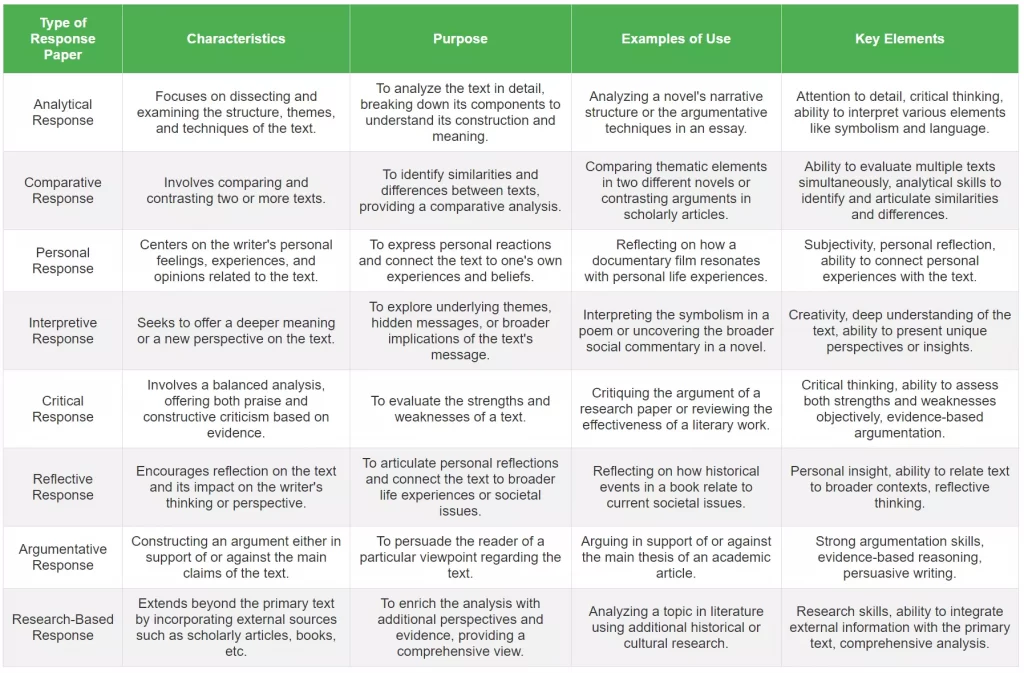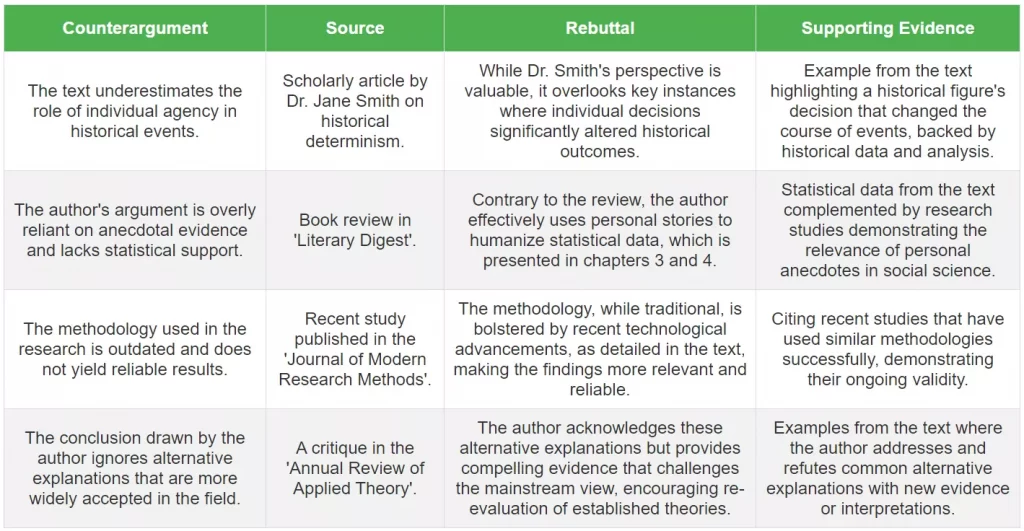A response paper, sometimes known as a reaction paper, is a distinct type of writing assignment commonly found in schools and universities. Its main purpose is to encourage the writer to express their thoughts, insights, and personal reflections on a specific text, which could be an article, book, film, or another type of media.

- Definition and Purpose
- A response paper is a critical reflection on a specific piece of work. It goes beyond mere summary, urging the writer to engage with the text deeper, analyzing its content, and expressing a personalized viewpoint.
- The purpose of a response paper is multifaceted. It demonstrates the writer’s understanding of the text, allowing for the expression of personal thoughts and opinions. It also encourages the development of critical reading skills, fostering the ability to evaluate arguments, identify strengths and weaknesses in a text, and articulate a reasoned response to its ideas.
- Significance in Academic and Professional Settings
- In academic contexts, response papers are valuable tools for assessing a student’s comprehension, analytical abilities, and engagement with course material. They allow students to synthesize and interpret information, enhancing their ability to argue effectively and thoughtfully.
- Beyond academia, response essays hold relevance in various professional fields, particularly those that require critical analysis and thoughtful reflection on texts and concepts. For example, in journalism, research, and policy-making, crafting coherent and insightful responses to texts is crucial for informing decisions, presenting arguments, and contributing to scholarly and public discourse.
Response papers are a vital component of both academic and professional landscapes, offering a platform for critical engagement, thoughtful analysis, and the expression of personalized viewpoints on diverse topics and texts.
Types of Response Papers
Response papers are available in different formats, each tailored to meet specific analytical needs and viewpoints. In this section, we will explore the various types of response essays, emphasizing their distinct characteristics and purposes. These types include:
- Analytical Response
- Focuses on breaking down the text into its core components to examine and interpret its structure, themes, and techniques. This type of response requires a deep analysis of elements like symbolism, language use, and narrative structure.
- Comparative Response
- Involves analyzing two or more texts to identify similarities and differences. This type of response paper emphasizes understanding each text in the context of the others, comparing themes, styles, or arguments.
- Personal Response
- Centers on the writer’s feelings, experiences, and opinions related to the text. It is subjective, allowing the writer to connect personal life experiences or beliefs with the content of the text.
- Interpretive Response
- Seeks to offer a more profound meaning or a new perspective on the text. This type often involves exploring underlying themes, hidden messages, or the broader implications of the text’s message.
- Critical Response
- Focuses on evaluating the strengths and weaknesses of a text. It involves a balanced analysis, offering both praise and constructive criticism based on evidence from the text and other scholarly sources.
- Reflective Response
- Encourages the writer to reflect on the text and its impact on their thinking or perspective. This type often includes personal reflections, connecting the text to broader life experiences or societal issues.
- Argumentative Response
- Involves constructing an argument either in support of or against the main claims of the text. This type requires the writer to present clear arguments backed by evidence to persuade the reader of their viewpoint.
- Research-Based Response
- Extends beyond the primary text by incorporating external sources such as scholarly articles, books, or interviews. This type of response paper enriches the analysis with additional perspectives and evidence, providing a more comprehensive understanding of the topic.
Each kind of response paper has its own purpose and needs a unique approach. By recognizing these differences, writers can select the best type for their goals and the material they are addressing, which will improve the depth and quality of their analysis and insights.

Pre-Writing Steps
The pre-writing process phase is a critical step in crafting a response paper. It sets the foundation for a well-structured and insightful paper. This section outlines the key pre-writing steps: thorough reading and analysis of the text, effective note-taking and highlighting, developing a clear thesis statement, and creating a structured outline.
- Read and Analyze the Text
- The first and foremost step is to read and analyze the text thoroughly. This involves more than a cursory glance; it requires deep engagement with the text’s content, structure, and style. Pay close attention to the author’s main arguments, themes, and the use of language. Consider the context in which the text was written and its relevance to contemporary issues.
- Take Notes and Highlight Key Points
- While reading, taking detailed notes and highlighting key points is crucial. This practice helps in organizing thoughts and forming a basis for the response. Jot down initial reactions, questions, and observations. Highlight significant quotes, evidence, and arguments that stand out. This step is instrumental in identifying patterns and crucial insights within the text.
- Develop a Clear and Concise Thesis Statement
- A thesis statement forms the backbone of your response paper. It should clearly articulate your main argument or perspective regarding the text. This statement should be based on your analysis and personal viewpoint. Ensure that it is specific, focused, and reflective of your engagement with the text. A well-crafted thesis statement guides the direction of your argument and provides coherence to your paper.
- Create a Structured Outline
- An outline is essential for organizing your thoughts and structuring your paper. It helps map out the paper’s flow, ensuring that each point and argument is logically placed. The outline should include an introduction that presents the thesis, body paragraphs that expand on your arguments with evidence from the text, and a conclusion that ties together your main points and reiterates the thesis.
Taking these important pre-writing steps is key to creating a response paper that is clear, persuasive, and shows a strong understanding of the text. By using this organized method, you can break down and examine the material more thoroughly, resulting in a deeper and more thoughtful response.

Write the Introduction
The introduction of a response paper sets the tone for the entire essay and is crucial for capturing the reader’s interest. It should be engaging, informative, and clearly state the purpose of your paper.
- Engage the Reader
- Begin the introductory paragraph with a compelling hook: a thought-provoking question, a striking fact, or a brief anecdote related to the text. This captures the reader’s attention and piques their curiosity.
- Provide a brief overview or preview of the main points you will discuss, creating intrigue and setting expectations for the reader.
- Provide Context and Background Information
- Introduce the text by mentioning the author, title, and publication details. This provides the reader with necessary background information.
- Offer a brief summary of the text’s main argument or theme, setting the stage for your response. This helps readers who may not be familiar with the text understand your perspective.
- Present the Thesis Statement Clearly
- Conclude the introduction with a clear and concise thesis statement. This statement should briefly present your main argument or reaction to the text.
- Ensure that your thesis reflects your analysis and viewpoint, providing a roadmap for the rest of your response essay.
Craft the Body of the Paper
The body of a response paper is where you delve into your analysis and argument, supported by evidence from the text.
- Use Evidence and Examples from the Text
- Support your arguments with relevant quotes, examples, and details from the text. This demonstrates a thorough understanding and provides a solid foundation for your analysis.
- Explain how each piece of evidence is relevant to your argument, making connections explicit.
- Analyze and Interpreting the Text
- Critically engage with the text, analyzing key themes, arguments, and stylistic elements. Discuss how these aspects support or contradict your thesis statement.
- Interpret the text in the context of your argument, offering a unique perspective or insight.
- Address Counterarguments and Alternative Perspectives
- Consider potential counterarguments or differing interpretations of the text. Acknowledge these perspectives and provide reasoned responses to them.
- This approach demonstrates critical thinking and adds depth to your analysis.

The Summary and Response Format
A response paper consists of two main parts: a summary of the original text and your personal thoughts or critique about it.
- Summary of the Main Ideas
- Start with a concise summary that covers the main ideas of the text. This should be neutral and factual, providing a foundation for your response.
- Avoid including your opinions in the summary; focus on the author’s arguments and key points.
- Response and Critique
- The response section is where you present your analysis and viewpoints. Here, engage critically with the text, offering your interpretations and evaluations.
- Back up your opinions with evidence, and relate them to the main themes or arguments of the text.
- Organizational Formats
- One common format is to present the summary and response in separate blocks: first summarizing the text, followed by your response.
- Alternatively, you can integrate the summary and response, addressing each main point of the text and immediately following with your reaction.
Conclude the Paper
The conclusion of a response paper is where you wrap up your analysis and restate your main points.
- Summarizing Key Points
- Briefly summarize the main arguments of your paper, reinforcing how they support your thesis.
- Avoid introducing new ideas; focus on bringing closure to the points you’ve already made.
- Reiterating the Thesis
- Restate your thesis to reflect the insights and arguments you have presented in the body of the paper.
- This reaffirms your stance and provides a coherent end to your response essay.
- Leaving a Lasting Impression
- Conclude with a final thought or question that leaves the reader pondering your perspective or the text itself.
- This creates a lasting impression, encouraging further reflection on the topic.

Read for more insights:
- Graff, G., & Birkenstein, C. (2014). They Say / I Say: The Moves That Matter in Academic Writing. W. W. Norton & Company. This book provides a comprehensive guide to academic writing, focusing on argumentation and the integration of one’s own voice with others’ ideas, which is crucial for response papers.
- Rosenwasser, D., & Stephen, J. (2011). Writing Analytically. Cengage Learning. This text offers strategies for developing analytical skills in writing, which are essential for crafting effective response papers.
- Booth, W. C., Colomb, G. G., & Williams, J. M. (2016). The Craft of Research, Fourth Edition. University of Chicago Press. This book is valuable for response paper writing as it guides developing a research question, gathering evidence, and constructing an argument.
- Lunsford, A. A. (2020). The Everyday Writer. Bedford/St. Martin’s. This guide provides practical advice on the nuts and bolts of writing, including structure and style, which are key components of a well-written response paper.
- Harris, M. (2017). Rewriting: How To Do Things With Texts, Second Edition. Utah State University Press. This book delves into revising and rewriting texts, a crucial skill for refining response papers and strengthening arguments.